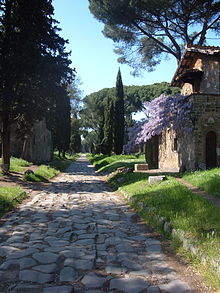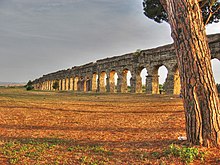Appian Way Regional Park
The idea of a great archaeological park between the Roman Forum and the Alban Hills dates back to Napoleonic times.
[5] After Italian unification further efforts were made to develop an archaeological walk from the city centre to Rome's southeast, but this only reached as far as the Baths of Caracalla.
[6] In 1931, a new plan envisaged the Appian Way to become a great park but this idea was threatened after the Second World War with the construction of illegal villas and sports clubs close to the monuments and other housing that encroached on the edges of the zone.
[5] Moreover, the new ring road for Rome, the Grande Raccordo Anulare, cut in two the Appian Way at the seventh mile, a mistake that was only rectified with the construction of a tunnel before the Great Jubilee of 2000.
The Park remains 95% in private hands: 40% is held by aristocratic Roman families; 25% by companies; 21% by small landowners and 10% by the Catholic Church.
On the orders of Pope Pius VI the road was restored and a new Appian Way was built in 1784 in parallel with the old one, as far as the Alban Hills.
Noted monuments along the route include Porta Appia (Porta San Sebastiano), the gate of the Aurelian Walls, the Tomb of Priscilla, the Christian catacombs of Saint Sebastian, and Callixtus and the Jewish catacomb of Vigna Randanini, the Circus and Mausoleum of Maxentius, the Tomb of Cecilia Metella, the Roman baths of Capo di Bove, the Tomb of Hilarus Fuscus, the Mausoleum of the Orazi and Curiazi and the Mausoleum of Casal Rotondo.
It extends lengthways from the Aurelian Wall up to the Via dell'Almone and contains several items of archaeological interest, as well as a working farm, and has considerable ecological value, with 78 species of birds and fauna.
Herodes Atticus was a Greek who became a Roman senator and through his marriage to Annia Regilla he acquired the land of the estate.





